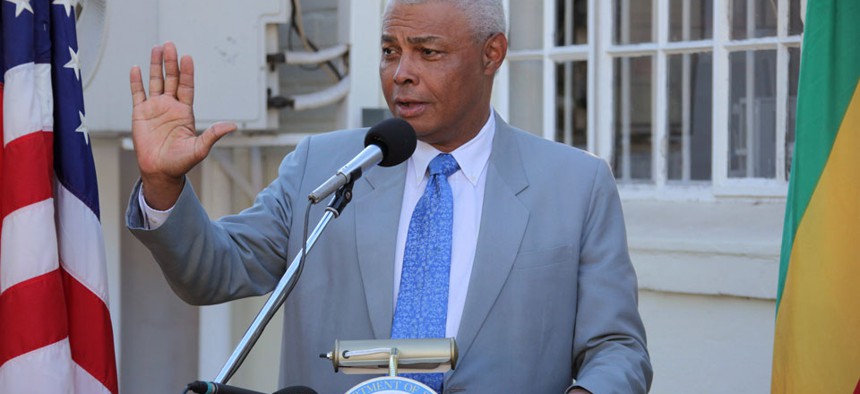
Retired Ambassador Charles Ray, who chaired the working group that began in November, said the group combined content from the 1980 Foreign Service Act with recommendations from the State Department inspector general, but “drew on our own experience." Tsvangirayi Mukwazhi/AP file photo
Foreign Service Group Wants to Raise the Bar on White House Nominees
Union unveils guidelines for ambassadorial appointments.
The Foreign Service union released new guidelines designed to raise the bar on qualifications of ambassadorial appointments, acknowledging the value of both career and non-career envoys but steering clear of some of President Obama’s currently controversial choices.
The Guidelines for Successful Performance as Chief of Mission are offered as “a useful reference for those participating in a confirmation hearing but should augment, not replace, existing guidelines in the 1980 Foreign Service Act,” Robert Silverman, president of the American Foreign Service Association, told reporters in a Tuesday conference call. “In recent weeks, we have seen a highly politicized environment, so these can be seen as a tool to move away from the rhetoric and gotcha” tactics, he said.
The guidelines were released during a month when Obama ambassadorial nominees to such countries as Norway and Argentina, who were Obama campaign donors, have drawn fire from lawmakers for appearing uninformed about their future countries of residence during Senate hearings.
“The guidelines may not seem earthshaking or ground-breaking, and appear to be common sense,” Silverman said. But this is first time his 16,000-member association that represents employees and retirees from five agencies has produced such a document, he said.
The blueprint stresses that in a world growing more complex, “chief of mission” or ambassadorial appointees from the Foreign Service, the political world and the private sector must display leadership, character and proven interpersonal skills; an understanding of high-level policy and operations and of key U.S. interests and values; management ability; and an understanding of the host country and international affairs.
The criteria were created by a 10-member working group of envoys with experience over eight administrations, AFSA said. The association’s briefings of the White House, Congress and agencies “have drawn a positive response,” Silverman said. Just as Congress was able to reform its longtime practice of earmarking of parochial spending, he added, “We hope these will aid in reforming the confirmation process.”
Retired Ambassador Charles Ray, who chaired the working group that began in November, said the group combined content from the 1980 Foreign Service Act with recommendations from the State Department inspector general, but “drew on our own experience, which we felt was missing from” the earlier guidelines, he said.
AFSA Vice President Matthew Asada said the report was not prompted by partisanship or a specific Obama nominee, noting that the issue of qualifications first emerged when AFSA’s new leadership took office in July 2013. Asada said the 1980 law already includes language frowning upon ambassadorial nominations whose main qualification is donating campaign money.
When pressed about the recent controversial nominees, the AFSA leaders said the association will consider taking positions at a March 5 meeting of its 28-member board of governors. The last time the association opposed a nominee was in the early 1990s involving President Clinton’s nomination of businessman and campaign donor M. Larry Lawrence to be the U.S. envoy to Switzerland. He went on to serve.
AFSA working group member James Jeffrey said he personally had questions about Obama’s pick of George Tsunis to go to Norway, but added that any decision on a statement of opposition would rest with the association’s board.
NEXT STORY: The Rise of Professional Women



